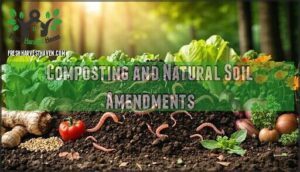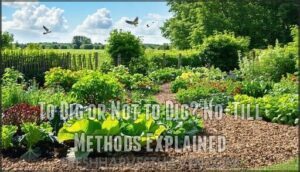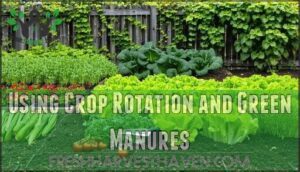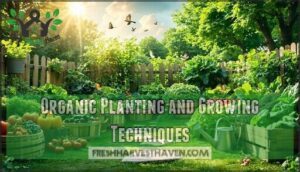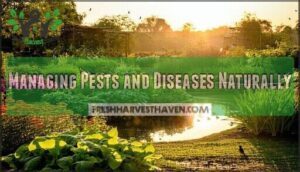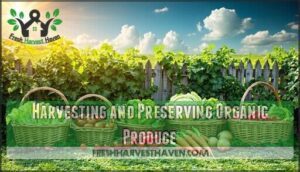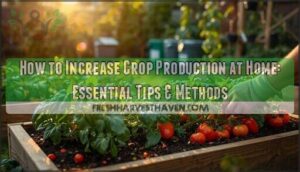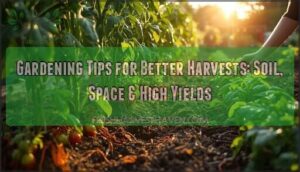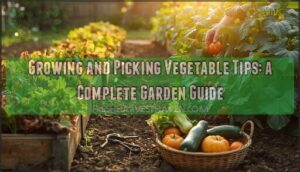This site is supported by our readers. We may earn a commission, at no cost to you, if you purchase through links.
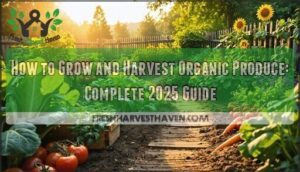
This shift from chemical dependence to ecological partnership requires rethinking everything from site selection to storage, but the reward extends beyond pesticide-free carrots. You’re building a system that feeds itself, protects itself, and produces food that tastes like food should—intensely flavorful because the nutrients came from decomposed leaves and earthworm castings, not a factory formula.
Table Of Contents
Key Takeaways
- Organic gardening succeeds when you recognize soil as a living ecosystem that feeds itself through compost, natural amendments, and beneficial microbes rather than relying on synthetic fertilizers that create dependency.
- Effective pest management stems from building ecological balance through companion planting, crop rotation, and encouraging natural predators—not waging chemical warfare against every insect that appears.
- Smart planning before planting matters more than any product you’ll buy later: choosing the right site with proper sunlight, testing soil drainage, and selecting crops suited to your climate determines whether your garden thrives or struggles.
- Timing your harvests correctly and preserving produce through freezing, canning, or dehydrating extends your garden’s productivity for months, transforming a single season’s work into year-round food security.
Planning Your Organic Garden
Every successful organic garden starts with a solid plan—one that considers your space, your goals, and what actually thrives in your conditions. Before you turn a single shovelful of soil, you’ll need to make three fundamental decisions that shape everything that follows.
Here’s what to think through first.
Choosing The Right Site and Layout
Before you plant a single seed, you need to stake out your garden’s future—and that starts with picking a spot where sun, soil, and access all work in your favor. Observe sun patterns throughout the day—most vegetables need six to eight hours of direct light. Check for microclimates near walls or slopes that trap warmth or cold.
Get your soil tested early—it’ll tell you if water drains well and what nutrients you’re working with before you commit to a layout.
Deciding What Organic Vegetables and Herbs to Grow
Once you’ve mapped your sunlight and tested your soil, the real fun begins: choosing crops that match your climate, skill level, and dinner table.
Start with vegetable gardening for beginners favorites—lettuce, radishes, and arugula thrive in weeks with minimal fuss. Growing organic herbs like basil or thyme demands little space but delivers big flavor.
Balance crop diversity with soil suitability and nutrient planning, selecting varieties suited to your zone’s frost dates and seasonal rhythms.
Maximizing Garden Space for Productivity
You’ve picked your crops—now it’s time to squeeze every possible harvest from the ground you’ve got. Space optimization transforms cramped plots into productive powerhouses through smart garden layout and vertical gardening:
- Train vining crops upward using trellises or stakes for instant square-footage gains
- Layer fast growers between slow ones through succession planting rhythms
- Pair complementary plants with companion planting strategies that share root zones
- Stack containers on shelves or walls for small-scale farming anywhere
- Eliminate unused gaps by tucking herbs into bed edges
Maximizing garden space for productivity means every inch earns its keep.
Building Healthy, Fertile Soil
Your soil isn’t just dirt—it’s the foundation that determines whether your organic garden thrives or struggles.
To build soil that actually feeds your plants year after year, you need to master three interconnected approaches that turn your garden bed into a living system.
Here’s how to transform ordinary ground into a nutrient-rich powerhouse that feeds your plants naturally.
Composting and Natural Soil Amendments
Healthy soil isn’t just dirt—it’s a living ecosystem that feeds your plants from the ground up, and composting is how you build that foundation without spending a fortune on synthetic fertilizers.
You can kickstart soil fertility management by layering kitchen scraps, yard waste, and organic matter into compost piles that feed soil microbes. Worm composting accelerates the process, transforming scraps into nutrient-dense natural fertilizers.
Add organic mulch around plants to retain moisture and slowly release nutrients, or brew compost tea to deliver a liquid boost of biology straight to your roots.
To Dig or Not to Dig? No-Till Methods Explained
Tilling has been the go-to method for generations, but here’s the catch—it might actually harm the soil you’re working so hard to improve.
No-till farming takes a different approach: skip the plow entirely, leave organic matter where it belongs, and let the soil structure do its thing while locking away carbon.
No-till farming builds soil health and supports sustainable agriculture by cutting down on erosion and compaction. Sure, you might see yields drop a bit at first—that’s normal—but once things stabilize, the payoff is solid: better soil conservation and a stronger foundation for organic gardening systems.
By adopting no till methods, gardeners can improve soil quality and promote a healthier ecosystem.
Using Crop Rotation and Green Manures
Rotating crops and planting green manures aren’t just old-school tricks—they’re two of the most powerful ways you can rebuild soil fertility without spending a dime on fertilizers.
Smart crop planning and rotation strategies prevent nutrient depletion while breaking pest cycles.
Green cover crops like clover or rye add organic matter and nitrogen, turning manure management and soil regeneration into a self-sustaining cycle that defines sustainable gardening techniques and organic gardening at its best.
Organic Planting and Growing Techniques
With healthy soil in place, you’re ready to plant.
The way you plant, water, and support your crops determines whether your garden thrives or just survives.
Here’s how to grow plants that are resilient, productive, and truly organic from seed to harvest.
Sowing Seeds and Transplanting Seedlings
Starting seeds indoors or sowing them directly into prepared soil gives you full control over what enters your garden from day one—no synthetic coatings, no chemical treatments, just pure organic potential. Choose certified organic seed and a quality seed starting mix free from synthetic additives.
Direct sowing tips: plant at proper depths and ideal spacing to prevent crowding. Transplant shock decreases when you harden off seedlings gradually before planting outdoors—your organic gardening practices depend on strong beginnings.
Water Conservation and Efficient Irrigation
Smart watering isn’t just about turning on a hose—it’s the difference between thriving plants and wasted resources. Organic gardens demand precision to keep soil life intact while conserving every drop.
Drip irrigation delivers water directly to root zones, reducing evaporation while preserving soil moisture and beneficial microbes essential for compost-rich beds.
Rainwater harvesting and greywater systems reclaim precious resources, turning water conservation into sustainable gardening practice that strengthens soil health and fertility without compromise.
Natural Methods for Supporting Plant Health
Your plants thrive on allies, not chemicals—natural defenses and living soil make all the difference. Here’s how to strengthen plant nutrition:
- Composts and natural fertilizers that feed soil microbes and boost soil health
- Organic mulching to regulate temperature and retain moisture
- Beneficial insects that provide integrated pest management without chemicals
- Natural pruning to improve airflow and prevent disease
These organic gardening practices build resilient crops from the ground up.
Managing Pests and Diseases Naturally
You can’t build a thriving organic garden by waging war on every bug that shows up—nature works best when you work with it, not against it.
The key is learning how to prevent problems before they start and manage the ones that do appear without reaching for synthetic chemicals.
Here are three ways to keep things healthy and balanced from spring through fall.
Biological Pest Control and Companion Planting
Biological control turns your garden into a living defense system. When you encourage natural predators like spiders and lacewings, you can slash aphid populations by half without reaching for sprays.
Companion planting—pairing calendula with cabbage or borage with strawberries—diverts pests and boosts beneficial insect numbers by 2.5 times during bloom. These organic methods form the backbone of integrated pest management, delivering eco-friendly results that actually work.
Diversified plantings cut pest damage by 22% compared to single crops, proving organic gardening practices build resilience from the ground up. To amplify these effects, consider employing effective intercropping methods.
Organic Disease Prevention and Management
Disease prevention starts with crop rotation—switching plant families every season drops soil-borne pathogens by 27% over four years. Pairing smart rotations with compost-amended soil boosts disease suppression by another 22%, giving you a fighting chance before trouble starts.
When fungal pressure hits, organic fungicides like sulfur or Bacillus subtilis knock down symptoms by 30–55%. These biological controls and organic gardening practices form your frontline defense, keeping pest management and soil health in sync without synthetic shortcuts.
Encouraging Biodiversity for Garden Balance
Once your soil and spray routine are dialed in, the real magic happens when you invite a full cast of beneficial organisms—pollinators, predators, and decomposers—to take up residence and hold the garden ecosystem steady year-round.
Plant native flowers alongside crop rotations to support pollinator populations while soil microbes thrive in compost-rich beds.
This ecological balance delivers ecosystem services that organic gardening depends on: natural pest management, nutrient cycling, and sustainable production without synthetic inputs.
Harvesting and Preserving Organic Produce
Knowing when to harvest and how to manage your organic crops can make or break a season’s work. The difference between a crisp, flavorful lettuce and a bitter one often comes down to timing and technique.
Here’s what you need to master the final—and most rewarding—stage of organic gardening.
Harvest Times for Popular Crops (Herbs, Greens, Roots)
Timing your harvest right makes all the difference in organic gardening. Different crops hit their sweet spot at different times—herbs need one approach, leafy greens another, and root vegetables their own schedule.
Get familiar with these patterns, and you’ll catch each crop when it’s at its absolute best for flavor and nutrition.
- Herbs: Harvest up to 75% of current growth before flowering; basil, cilantro, and dill can be cut continually through summer, leaving 4–6 inches for regrowth
- Leafy Greens: Lettuce and spinach mature in 45–60 days with leaves 4–8 inches long; kale and chard offer multiple harvests over 80 days
- Root Vegetables: Radishes reach harvestable size in 25–40 days; carrots and beets need 60–80 days, while parsnips require 90–130 days and benefit from light frost
- Timing Strategy: Morning harvests after dew dries capture peak flavor; stop cutting perennial herbs one month before frost to protect root development
Best Practices for Picking and Handling Produce
The way you pick and manage your harvest determines whether those organic vegetables reach your table at their best or lose quality before you even walk inside. Use sharp, clean tools to prevent bruising and disease spread during harvesting.
Manage homegrown produce gently—crushing leaves or splitting roots invites decay and pest control problems later. Crop monitoring reveals ideal harvest timing when flavor peaks, while careful vegetable gardening techniques protect fragile skin and preserve nutritional value throughout post-harvest management in your organic gardening system.
Storing and Preserving Your Organic Harvest
Your freshly picked organic harvest won’t last three days if you store it wrong—but master a few preservation methods and you’ll enjoy homegrown flavor for months. Extend your garden’s bounty with these techniques:
- Freezing Methods lock in nutrients from leafy greens and berries within hours of harvesting
- Canning Techniques preserve tomatoes and beans while maintaining soil health through composting waste
- Dehydrating Foods concentrates flavors in herbs after proper pest control during growth
- Root Cellars keep root vegetables fresh using cool, humid conditions that mirror natural storage
Frequently Asked Questions (FAQs)
What certifications do small organic growers need?
If you’re selling less than $5,000 worth of produce annually, you don’t need organic certification under the USDA National Organic Program.
That said, sticking to National Organic Standard practices helps you build customer trust and sets you up well if you decide to pursue formal certification down the road.
How do organic yields compare to conventional?
When you compare yields side by side, conventional farming typically pulls ahead per acre in the near term. But organic methods build something more valuable: healthier soil and genuine sustainability that closes the gap over time while cutting environmental damage—all within the National Organic Standard framework.
Can you use animal manure in organic gardens?
Yes—animal manures are prized organic fertilizers. Fresh manures need composting first to eliminate pathogens and prevent nutrient burn.
Properly aged composts, green manures, and compost tea deliver safe, natural amendments that build soil fertility without synthetic inputs.
What fertilizers are approved for organic production?
Approved options include animal manures, composts, green manures, and biological additives like bone meal or fish emulsion.
Natural fertilizers must meet the National Organic Standard, which prohibits synthetic chemicals while encouraging soil amendments that build organic matter naturally.
How long does organic certification typically take?
The certification process takes three years from the day you transition to organic practices. You’ll need a farm inspection, documentation showing you meet USDA National Organic Standard Board guidelines, and annual renewals.
Certification fees cover the verification that your gardening practices align with national organic standards.
Conclusion
Your first harvest will coincide with a revelation most gardeners miss: growing and harvesting organic produce isn’t about substituting one product for another—it’s about stepping outside a system designed to keep you dependent.
Organic gardening isn’t about swapping products—it’s about escaping a system that keeps you dependent
The soil you’ve been feeding will feed you back with compound interest, and those pest-resistant plants you’ve nurtured through companion planting and biodiversity won’t need your constant intervention.
You’ve built something resilient, something that works with nature instead of against it, and that independence tastes better than any store-bought tomato ever could.
- https://www.organicproducenetwork.com/organic-retail/organic-sales-surge-to-9-5-billion-outpacing-conventional-produce
- https://organicgrower.info/news/ota-2025-organic-report/
- https://www.farmprogress.com/organic/organic-stands-out-in-a-growing-sea-of-labels
- https://www.organicseurope.bio/news/study-on-the-environmental-impacts-of-achieving-25-organic-land-by-2030-published/
- https://www.technologyreview.com/2019/10/22/132497/sorryorganic-farming-is-actually-worse-for-climate-change/

